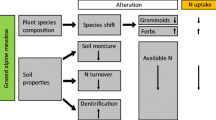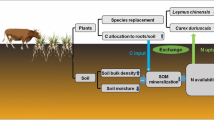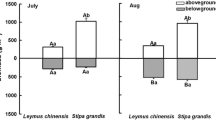Abstract
Western red cedar (Thuja plicata Donn.), western hemlock (Tsuga heterophylla Raf. Sarge) and salal (Gaultheria shallon Pursh) are the main species growing in cedar–hemlock forests on Vancouver Island, Canada. Based on the dominance of organic N in these systems, we tested the hypotheses that: (1) organic N can be utilized by the three plant species; and (2) salal, which is ericoid mycorrhizal and has high tannin concentration in its tissues, would absorb more N from the complex organic N compounds than the other two species. The abilities of cedar, hemlock and salal to take up 15N,13C-labelled glutamic acid were measured and the capacities of the three species to use nitrate (NO −3 ), ammonium (NH +4 ), glutamic acid, protein and protein–tannin N were compared over a 20-day period. Based on 13C enrichment, all three species absorbed at least a portion of glutamic acid intact. Cedar, hemlock and salal also showed similar patterns of N uptake from the NO −3 , NH +4 , glutamic acid, protein and protein–tannin treatments. The largest proportions of applied N were taken up from the NO −3 and NH +4 treatments while smaller amounts of N were absorbed from the organic N compounds. Thus organic N was accessed to a modest degree by all three species, and salal did not have a greater capacity to utilize protein and protein–tannin–N.






Similar content being viewed by others
References
Abuzinadah RA, Read DJ (1986) The role of proteins in the nitrogen nutrition of ectomycorrhizal plants III. Protein utilization by Betula, Picea and Pinus in mycorrhizal association with Hebeloma crustuliniforme. New Phytol 103:507–514
Bajwa R, Read DJ (1985) The biology of mycorrhiza in the Ericaceae. IX. Peptides as nitrogen sources for the ericoid endophyte and for mycorrhizal and non-mycorrhizal plants. New Phytol 101:459–467
Bending GD, Read DJ (1996) Nitrogen mobilization from protein-polyphenol complex by ericoid and ectomycorrhizal fungi. Soil Biol Biochem 28:1603–1612
Bennett JN, Andrew B, Prescott CE (2002) Vertical fine root distributions of western red cedar, western hemlock and salal in cedar–hemlock forests on northern Vancouver Island. Can J For Res 32:1208–1216
Bennett JN, Prescott CE, Barker JE, Blevins DP, Blevins LL (2003) Long-term improvement in productivity and nutrient availability following fertilization and vegetation control on a cedar–hemlock cutover. Can J For Res 33:1516–1524
Bradford MM (1976) A rapid and sensitive method for the estimation of microgram quantities of protein utilizing the principle of protein-dye binding. Anal Biochem 72:248–254
Chalot M, Brun A (1998) Physiology of organic nitrogen acquisition by ectomycorrhizal fungi and ectomycorrhizas. FEMS Microbiol Rev 22:21–44
Chapin FS III, Moilanen L, Kielland K (1993) Preferential use of organic nitrogen for growth by a non-mycorrhizal arctic sedge. Nature 361:150–153
DeMontigny L (1992) An investigation into the factors contributing to the growth-check of conifer regeneration on northern Vancouver Island. Dissertation, University of British Columbia
Ehrenfeld JG, Kaldor E, Parmelee RW (1992) Vertical distribution of roots along a soil toposequence in the New Jersey Pinelands. Can J For Res 22:1929–1936
Finlay RD, Frostegard A, Sonnerfeldt A-M (1992) Utilization of organic and inorganic nitrogen sources by ectomycorrhizal fungi in pure culture and in symbiosis with Pinus contorta Dougl. ex Loud. New Phytol 120:105–115
Gegenheimer P (1990) Preparation of extracts from plants. In: Deutscher MP (ed) Methods of enzymology. A guide to protein purification, vol 182. Academic, New York, pp 174–193
Green RN, Klinka K (1994) A field guide to site identification and interpretation for the Vancouver forest region. Crown, Victoria
Green RN, Trowbridge KL, Klinka K (1993) Toward a taxonomic classification of humus forms. For Sci Monogr 29 [suppl Sci 39]
Griffiths RP, Caldwell BA (1991) Mycorrhizal mat communities in forest soils. In: Read DJ, Lewis DH, Fitter AH, Alexander IJ (eds) Mycorrhizas in ecosystems. CAB International, Wallingford, pp 98–105
Hannam KD, Prescott CE (2003) Soluble organic nitrogen in forests and adjacent clearcuts in British Columbia, Canada. Can J For Res 33:1709–1718
Kerley SJ, Read DJ (1995) The biology of mycorrhiza in the Ericaceae: XVIII. Chitin degradation by Hymenoscyphus ericae and transfer of chitin-nitrogen to the host plant. New Phytol 131:369–375
Kielland K (1994) Amino acid absorption by arctic plants: implications for plant nutrition and nitrogen cycling. Ecology 75:2373–2383
Kormanik PP, McGraw A-C (1984) Quantification of Vesicular–Arbuscular mycorrhizae in plant roots. In: Schenck NC (ed) Methods and principles of mycorrhizal research. The American Phytopathological Society, USA, pp 37–45
Leake JR, Read DJ (1990) Proteinase activity in mycorrhizal fungi: I. The effect of extracellular pH on the production and activity of proteinase by ericoid endophytes from soils of contrasted pH. New Phytol 115:243–250
Lewis T (1985) Ecosystems of Quatsino Tree-Farm License (TFL 6). Internal report. Western Forest Products, British Columbia
Lewis JA, Starkey RL (1968) Vegetable tannins, their decomposition and effects on decomposition of some organic compounds. Soil Sci 106:241–247
Lipson DA, Monson RK (1998) Plant-microbe competition for soil amino acids in the alpine tundra: effects of freeze-thaw and dry-rewet events. Oecologia 113:406–414
Lipson DA, Raab TK, Schmidt SK, Monson RK (1999) Variation in competitive abilities of plants and microbes for specific amino acids. Biol Fertil Soils 29:257–261
Lipson DA, Raab TK, Schmidt SK, Monson RK (2001) An empirical model of amino acid transformations in an alpine soil. Soil Biol Biochem 33:189–198
Miller AE, Bowman WD (2003) Alpine plants show species-level differences in the uptake of organic and inorganic nitrogen. Plant Soil 250:283–292
Nadelhoffer K, Shaver G, Fry B, Giblin A, Johnson L, McKane R (1996) 15N natural abundances and N use by tundra plants. Oecologia 107:386–394
Nasholm T, Persson J (2001) Plant acquisition of organic nitrogen in boreal forests. Physiol Plant 111:419–426
Nasholm T, Ekblad A, Nordin A, Giesler R, Hogberg M, Hogberg P (1998) Boreal forest plants take up organic nitrogen. Nature 392:914–916
Nasholm T, Huss-Danell K, Hogberg P (2000) Uptake of organic nitrogen in the field by four agriculturally important plant species. Ecology 81:1155–1161
Nasholm T, Huss-Danell K, Hogberg P (2001) Uptake of glycine by field grown wheat. New Phytol 150:59–63
Neter J, Kutner MH, Nachtsheim CJ, Wasserman W (1996) Applied linear statistical models, 4th edn. McGraw-Hill, Chicago
Nordin A, Hogberg P, Nasholm T (2001) Soil nitrogen form and plant nitrogen uptake along a boreal forest productivity gradient. Oecologia 129:125–132
Northup RR, Dahlgren RA, Zengshou Y (1995a) Intraspecific variation of conifer phenolic concentration on an marine terrace soil acidity gradient; a new interpretation. Plant Soil 171:255–262
Northup RR, Zengshou Y, Dahlgren RA, Vogt KA (1995b) Polyphenol control of nitrogen release from pine litter. Nature 377:227–229
Persson J, Hogberg P, Ekblad A, Hogberg M, Nordgren A, Nasholm T (2003) Nitrogen acquisition from inorganic and organic sources by boreal forest plants in the field. Oecologia 137:252–257
Powlson DS, Barraclough D (1993) Mineralization and assimilation in soil-plant systems. In: Knowles R, Blackburn TH (eds) Nitrogen isotope techniques. Academic, San Diego, pp 209–242
Prescott CE, Weetman GF (1994) Salal Cedar Hemlock integrated research program: a synthesis. Faculty of Forestry, University of British Columbia, Vancouver
Preston CM (1999) Condensed tannins of salal (Gaultheria shallon Pursh.): a contributing factor to seedling “growth check” on northern Vancouver Island. In: Gross GG, Hemingway RW, Yoshida T (eds) Plant polyphenols 2: chemistry, biology, pharmacology, ecology. Basic life series, vol 66. Kluwer /Plenum, New York, pp 825–841
Read DJ (1991) Mycorrhizas in ecosystems. Experientia 47:376–390
Sambrook J, Fritsch EF, Maniatis T (1989) Molecular cloning, vol 3. A lab manual. 2nd edn. Cold Spring Harbour Laboratory, New York
SAS Institute (1993) SAS/SYSTAT User’s Guide. Rel. 6.07. SAS Institute, N.C.
Schimel JP, Chapin FSI (1996) Tundra plant uptake of amino acid and NH4 nitrogen in situ: plants compete well for amino acid N. Ecology 77:2142–2147
Schmidt S, Stewart GR (1997) Waterlogging and fire impacts on nitrogen availability and utilization in a subtropical wet heathland (wallum). Plant Cell Environ 20:1231–1241
Schulze E-D, Chapin FSI, Gebauer G (1994) Nitrogen nutrition and isotope differences among life forms at the northern treeline of Alaska. Oecologia 100:406–412
Stewart GR, Pate JS, Unkovich M (1993) Characteristics of inorganic nitrogen assimilation of plants in fire-prone Mediterranean-type vegetation. Plant Cell Environ 16:351–363
Taiz L, Zeiger E (1991) Plant physiology. Benjamin/Cummings, Redwood City
Turnbull MH, Goodall R, Stewart GR (1995) The impact of mycorrhizal colonization upon nitrogen source utilization and metabolism in seedlings of Eucalyptus grandis Hill ex Maiden and Eucalyptus maculate Hook. Plant Cell Environ 18:1386–1394
Weetman GF, Fournier R, Barker J, Schnorbus-Panozzo E (1989) Foliar analysis and response of fertilized chlorotic western hemlock and western red cedar reproduction on salal-dominated cedar–hemlock cutovers on Vancouver Island. Can J For Res 19:1512–1520
Xiao G-P (1994) The role of root-associated fungi in the dominance of Gaultheria shallon. Dissertation, Department of Soil Science, University of British Columbia, Vancouver
Acknowledgements
We thank Myrna Bennett for laboratory support and Rob Guy, Brian Ellis, Caroline Preston and Shannon Berch for technical support. We also express appreciation to Western Forest Products Ltd. for accommodation, use of equipment while in Port McNeill and partial funding for the project. The research was also funded by a Forest Renewal British Columbia grant to Cindy E. Prescott and scholarships from the Natural Sciences and Engineering Council of Canada and the Science Council of British Columbia to Jennifer N. Bennett
Author information
Authors and Affiliations
Corresponding author
Rights and permissions
About this article
Cite this article
Bennett, J.N., Prescott, C.E. Organic and inorganic nitrogen nutrition of western red cedar, western hemlock and salal in mineral N-limited cedar–hemlock forests. Oecologia 141, 468–476 (2004). https://doi.org/10.1007/s00442-004-1622-3
Received:
Accepted:
Published:
Issue Date:
DOI: https://doi.org/10.1007/s00442-004-1622-3




